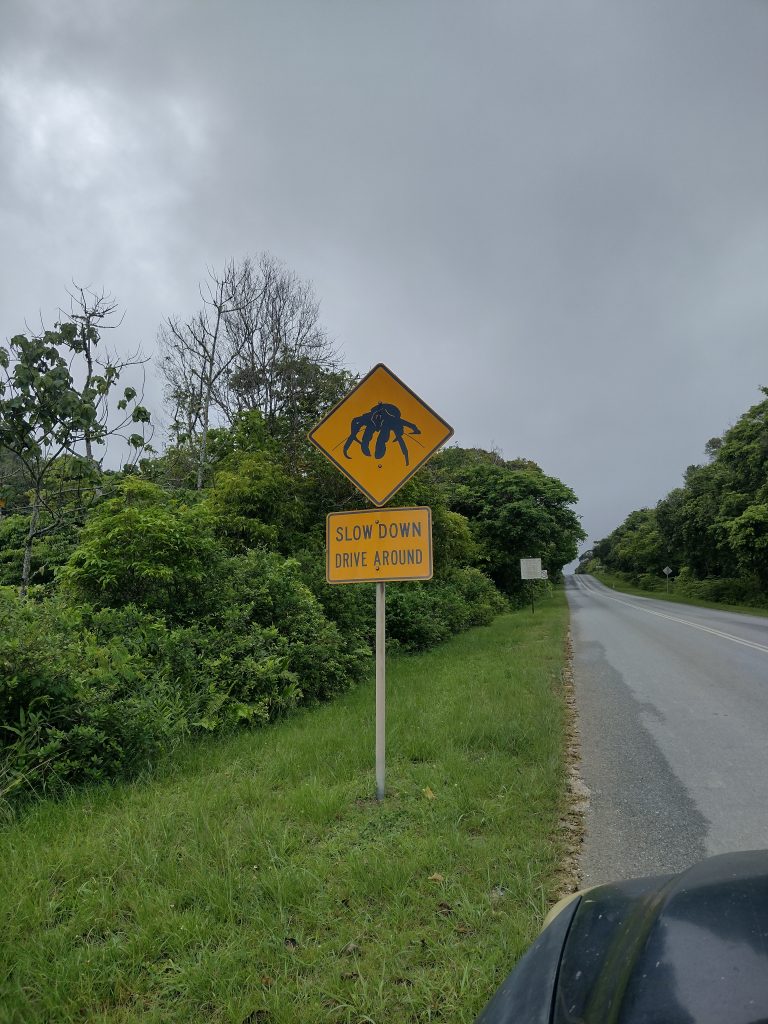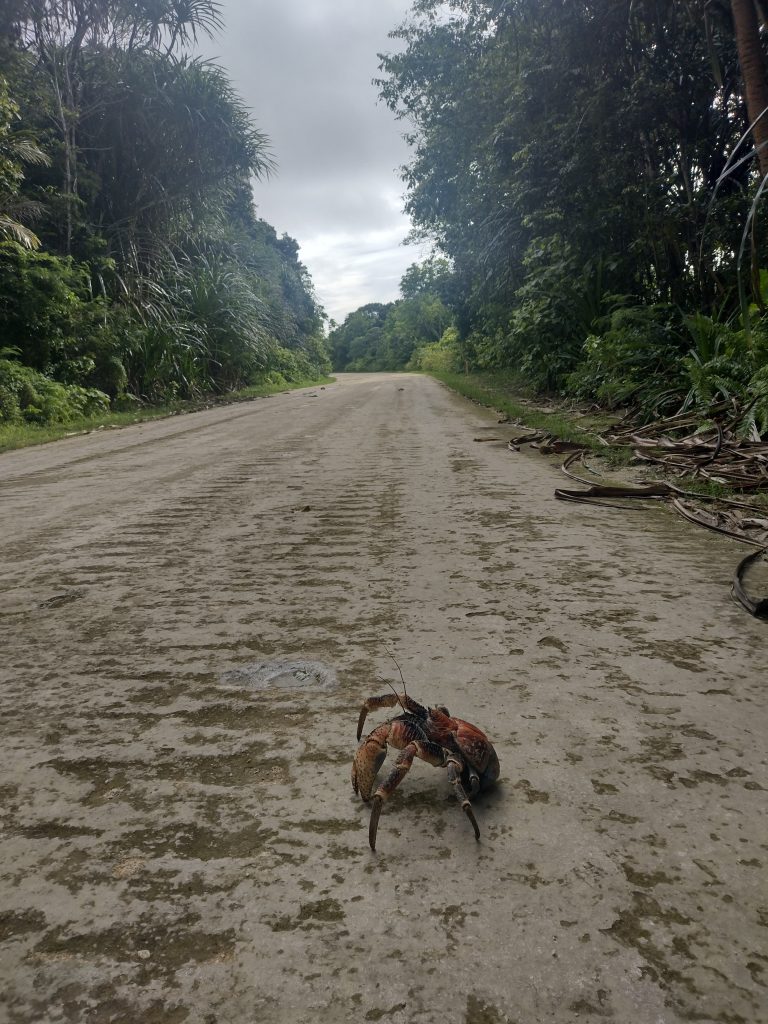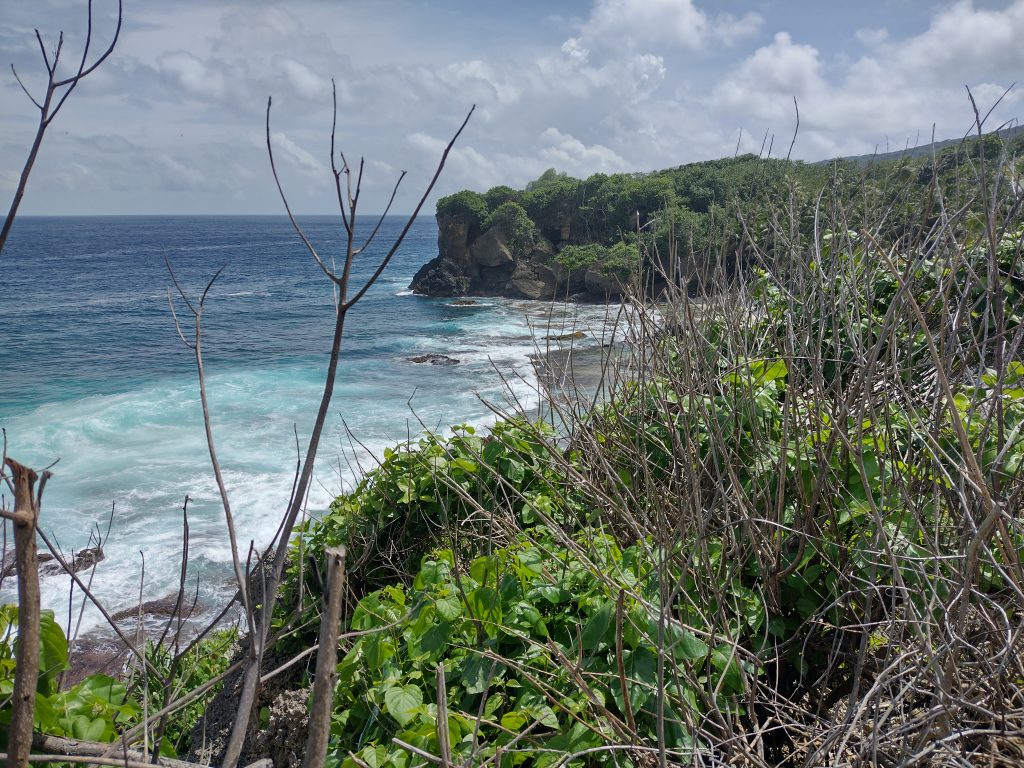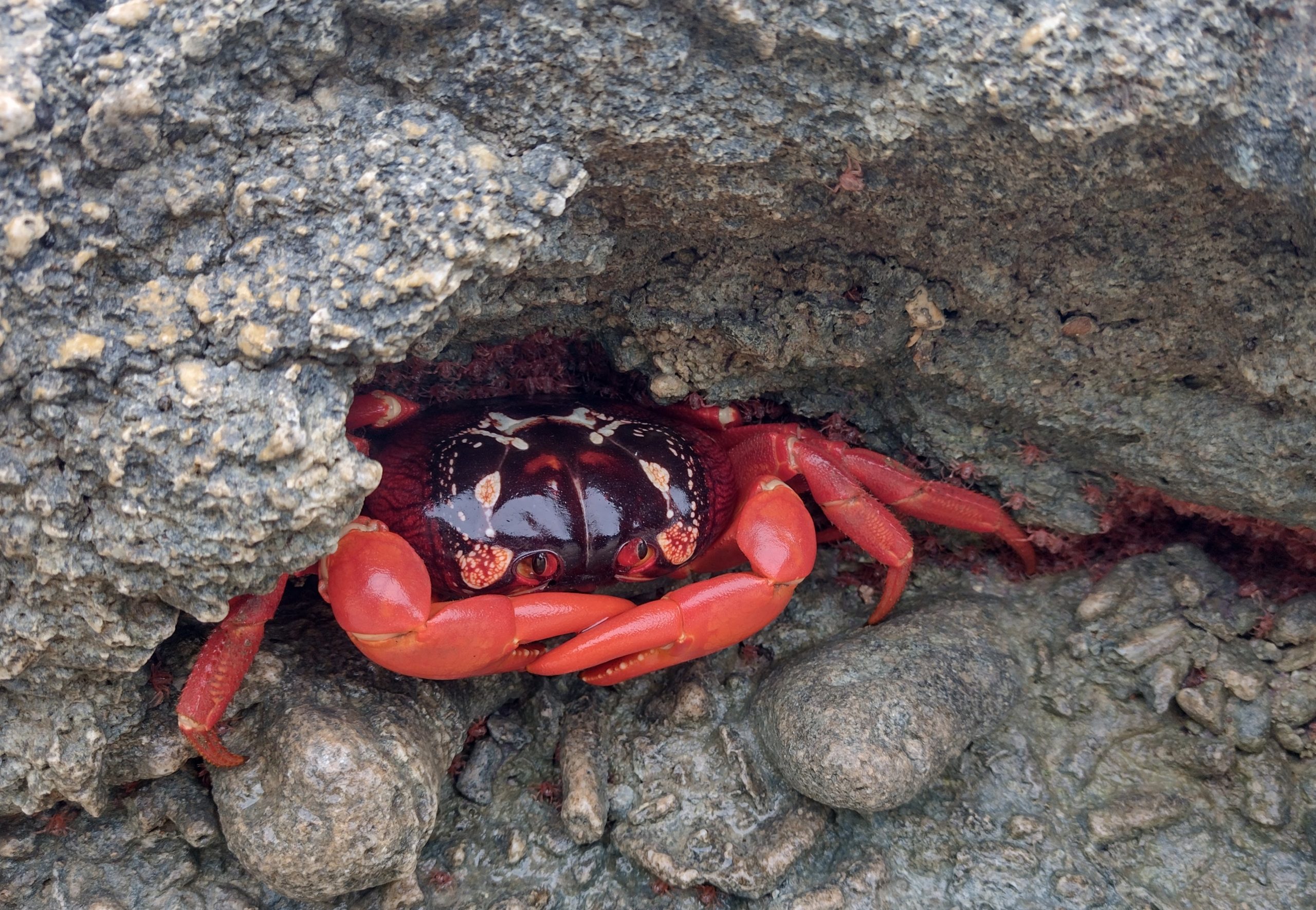As the small plane banked, the world turned green. I had removed my nose from the windowpane when the solid blue sky of Perth became bubbly-white and then finally a dull, flat grey in confirmation of our suspicions, as we neared the island: the wet season means rain. Yet as we came in to land the tip of the wing pushed it all to one side and all we could see was forest – dense, continuous, and probably virgin – over the summits we almost skimmed, right down to the dazzling, surf-rimmed coves and viridian ocean below.
I had no idea! Unusually, I hadn’t done any research; I hadn’t found the time. I’d delegated all arrangements to Angela months earlier, and pretty much forgotten about it. Whatever it was, it would be cool – we were going to see some crabs. If they’d been good enough for Sir David Attenborough thirty-five years ago, when I’d watched, transfixed, they’d be good enough for me. Unbroken swathes of misty forest and picture-perfect curves of pale sand I had not anticipated; suddenly I was on full alert. Far from a short, pleasant interlude during my extended trip, this was beginning to look like the main event.
Walking across the tarmac to the tiny, one-roof terminal, while avoiding the hand-written sign pointing left for passengers to the Cocos Islands – that would be us, in a week – the dominating colour now was red, as we were greeted by a sea of locals, from airline staff to accommodation representatives to police officers, each sporting a scarlet Santa hat wishing us a Merry Christmas Island.
It was December 24th, around 4pm. The local supermarket closed at 6pm, we were informed with little urgency, and no bars or restaurants would open until the day after tomorrow at the earliest. We’d better call in there on our way – they didn’t think there’d be much left on the shelves, though, and probably no vegetables. Suddenly ‘Christmas’, which I don’t usually celebrate in any case, was not looking so merry after all. Others had come prepared, but we had received no warning. I mean, how many tourist destinations shut themselves down for Christmas and New Year? With such a captive audience, desperate for a drink? Of course, this island is no ordinary destination, and it wasn’t even ‘high season’ what with the rain and all. We were just a bunch of oddballs braving mosquitoes, pre-dawn hyperthermia and now starvation, to see a few red crabs.
Angela had arranged a rental car.
‘A 4×4 is included in with the package,’ she’d told me, I now remembered, when I’d already agreed that we should just book it. I was always up for a wildlife experience, especially a unique one, and the price had seemed reasonable, considering. I hadn’t originally intended to squeeze in anything of the sort between my visits to Bali and Australia. But Christmas Island for Christmas? Coinciding perfectly with the red crab migration, when I was already in the vicinity? It seemed rude not to. What’s more it would be nice to spend time with Angela, who moved back to New Zealand several years ago and not been seen since. I said yes, and let her deal with it.
The man who approached us appeared a little tipsy, his Santa hat bobbing as he led us to our car, jingling the key. We wouldn’t need it for locking the car, we were assured. There was no such crime here. After all, with fewer than two thousand residents and just a handful of roads around its fifty-two square miles, nobody was going to be taking it anywhere. Looking at it, they wouldn’t have wanted to. As soon as we managed to shut the battered, rusting doors and sat ourselves down, Angela wound down her window, the entire winding apparatus coming off in her hand. Both windows were now stuck firmly down, just as the first serious raindrops began to fall.
‘Oh dear, try this one,’ the renter wasn’t concerned, and led us to a slightly less battered, but very dusty version across the car park. We settled ourselves inside once more as he scurried away, eager to be home, we guessed, with a glass of something celebratory. Or perhaps he was in an equal hurry to reach the shop and grab the last available tomato before I pounced on it. There was an overwhelming smell of something…unhealthy. Hopefully it would escape out of the windows and that they would wind up again. Angela turned the key: nothing. I went to find him.
‘Hahaha sorry,’ he seemed amused. Perhaps this was a test? Were we rugged enough for Christmas Island? ‘It hasn’t been used in a while.’ That would explain the smell, then.
He ran off once more with the paperwork, brought it back crumpled and damp, and we signed for the third time, the previous numbers scribbled out with biro. I couldn’t even read what we were signing. There wasn’t time.
‘You can take mine.’ We supposed he wouldn’t be driving anywhere for the next week, then.
He opened the door to a Toyota Rav in a marginally better state of repair than the previous two, brushing crumbs from the driving seat and gathering up personal bits and bobs from the back. This one was fine; until I went to slap one of the ten million mosquitoes that entered with us after one of our wet, sticky walks and my hand went straight through the glove compartment door, the sun-bleached plastic shattering like glass.
It wasn’t until we’d called into the police station to pick up our special ‘locating beacon’, in case we broke down without phone signal somewhere on the island and needed assistance (I found this funny – at the time), then stormed the small, interestingly-stocked, Malay-run supermarket and panic-bought $150-worth of unidentified, but microwaveable, foodstuffs and filled our fridge to a comforting level; until we’d stumbled in at the end of the welcome talk and downed what was left of the wine and nibbles, in time to learn only that we would all meet at three the next morning – yes, Christmas morning – with our umbrellas (what umbrellas?), that I finally began to realise where we were. This was like nowhere I’d ever been before. This was, in fact, like nowhere else, full stop; at least, that’s what I believed, soaked by the warm rain, on Christmas Eve; the bar across the road in complete darkness and the whole village, it seemed, asleep at nine. We opened a bottle of the duty-free wine we’d thankfully bought, and toasted the adventure just begun. I started to giggle; I loved it already.
The main spawning event had been predicted for December 24th 2024, the day we arrived; it was supposed to last, in its full intensity, for two or three days. It was on the strength of this assumption we booked the trip. Of course, the exact timing depends upon several factors: the moon (known in advance); the arrival of the rainy season and, presumably, the whim of the crabs themselves.
The red crabs, endemic to Christmas Island and the Cocos Islands, make an annual mass migration to the ocean, where they mate, incubate and finally discharge their eggs. At its peak, this event sees millions of crabs emerging from the forest, halting traffic and covering the ground in a thick, orange-red carpet. This takes at least a week. The male crabs usually arrive before the females, to dig a burrow out all ready for a lucky mate. Once the deed is done the male will return to the forest, leaving the female in the burrow for another fortnight. During this time she’ll lay her eggs and incubate them in her abdominal pouch. At the turn of the high tide, during the last quarter of the moon, she’ll enter the waves, releasing the egg-pouch with a little ‘victory dance’, pincers in the air, before returning to the jungle for the rest of the year.
The eggs hatch on contact with the water and the larvae will wait for the swell to take them out to sea, where they’ll remain for three or four weeks before emerging as juveniles, so tiny they could be mistaken for miniature spiders. These baby crabs then leave the water and journey to the centre of the island, creating a bright red, slow-moving ‘puddle’ across the roads. During this phase, much of the island will be closed to traffic until they are safely in the forest, where they remain hidden in rocks and trees until they reach sexual maturity. They’ll begin the migration ritual themselves when they’re four or five years old.
This series of events is one of the greatest and most unusual wildlife spectacles in the world, and it’s what we’d come to see. It just so happened that the crabs couldn’t wait; we’d arrived at the tail-end of it, late to the party, and in order to catch the stragglers, we had to appear on a rain-sodden beach at 3am, Christmas morning.
There were crabs everywhere: on rocks; on sand; under our feet; on the path; climbing up the railings. Later we watched one navigate up and over the house opposite, waiting (to catch its breath?) on the roof, before descending inexplicably down the other side. I sat on a wet rock under a borrowed umbrella in the warm, damp night and watched them rush into the surf, a brilliant white in the light of people’s phones. There were around thirty of us that morning, all ages and nationalities, drawn together to witness this mesmerising occurrence. As a sliver of pink cracked the sky we made our way back up the beach and to Flying Fish Cove, where breakfast had been prepared for us: a bean feast for me, which I devoured while watching a pair of golden bosun, (a type of long-tailed tropic bird, endemic to the island and extremely beautiful), circling overhead.
In the days that followed, we grew so used to being surrounded by crabs it ceased to be peculiar. With over forty-three million of them on the island, we were flicking them, brushing them, delicately lifting them, swerving around them and dreaming about them. Most of our waking moments involved either trying to photograph them or get them out of the damn way so as not to harm them. There are few many sounds more sickening than the crunch of tyre on brittle shell when you’ve gone to great lengths to avoid it.
‘They can be suicidal,’ the police officer had warned us. ‘They throw themselves under your wheels and there’s not much you can do about it.’
During the annual breeding march, the red crabs have to cross several roads to reach the sea and then on the return journey back to the forest, and thousands are crushed by vehicles each year. There are now special underpasses with barriers designed to encourage the creatures towards them, and a ‘crab bridge’ across one of the key roads, helping to reduce the number of casualties. However, nothing can replace a bit of patience and respect on behalf of the road users and on the whole, the Christmas Island residents exercise this. At peak times the most thickly-carpeted roads are closed to the public, keeping the local rangers gainfully employed, as they drive around trying to predict where they’ll pop up next.
Despite all this, the roads are littered with carcasses. In the tropics, fortunately, nothing is wasted and the loss of one life helps another. In a jarring reminder not to anthropomorphise, crabs eat crabs, in front of crabs. Usually, but not always, the unlucky reds are ‘utilised’ by the other species prolific on the island: the pretty blue-headed and the outrageously large, strikingly-coloured ‘robber’, or coconut crabs, who will scavenge anything, from anyone. While alive, the adult red crabs have no native land predators, although an accidentally-introduced ant has played havoc with the population. As larvae, they must survive fish, rays and whale sharks, who come visiting during the breeding season. If they make it into adulthood, their lifespan could be boosted by learning a little road-sense.

While the main draw of Christmas Island, for us at least, is the crabs, there is a lot of endemic flora and fauna worthy of note. Apart from the frigate birds, tropic birds, finches and the Christmas Island thrush, there are three species of booby, all of which we saw: red-footed, brown and the rare Abbott’s booby which we observed, with well-grown chick, on its nest. There are trees full of flying foxes and a giant gecko which we didn’t encounter; our theory was that he was lying in a corner somewhere digesting the trillion mosquitoes he’d already consumed, with many more still to catch. Ah, the joys of visiting in the rainy season.
There are 237 native plant species on the island; about half are not found elsewhere is Australia and seventeen are endemic to Christmas Island only. With its hot, wet climate along with geographical isolation, unique geology and soil types, it’s a bit of a diversity hot-spot. It is also strange to be on Australian soil, as it were, whilst being far closer to Java. Such is colonialism, I suppose.

The island gets its name from a chap called William Mynors who sailed past it on December 25th 1643. From then onwards its fate was sealed, and a rather murky period of history begun. During naturalist expeditions, where biological and mineralogical samples were taken, the island’s abundant phosphate deposits were discovered, and it was annexed by Britain in 1888. Commercial mining commenced the following year. Christmas Island was administered by the UK and Singapore, with workers brought in from Singapore, Malaysia (then British Malaya) and China. Angela and I drove down to the disused, overgrown South Point railway and learned about the sad lives and shameful treatment of the Coolies.
We’ve heard of coolie hats, (the ones seen in historic rural Chinese paintings, a typical ‘Chinaman’s hat’), and coolie lampshades, so-called for their shape. But how many of us knew the origins of the term? Coolies were the Chinese miners who worked on Christmas Island in the late 1800s and 1900s, with the name used to describe their low social status – at the bottom of the heap, basically. Often single men who left their families behind, they faced exploitation, disease and, in many cases, death. In addition, the Japanese hunted them down in the jungle during their WW2 occupation of the island.
Australia gained sovereignty of Christmas Island in 1958, after paying £2,800,000 compensation to Singapore for lost mining revenue. The day is still celebrated as ‘Territory Day’ by the residents, now an interesting and ostensibly peaceful mix of Chinese, Malay, Indian and European Australian. The lady who cleaned our hotel was from Palau. She didn’t really like living there, she told us, but her husband worked in the mines and the pay was better than it would be at home. A subtler form of exploitation, these days.
In such gorgeous surroundings it’s hard to stay mad at history for long. During our short week we visited every corner that was not barricaded off due to floods of crab, or in one case, floods of water. Walking with the newly-purchased umbrella became the norm, shielding us from torrential downpours as well as the baking sun once it had reappeared. My white canvas trainers turned a pinkish-brown in the ankle-deep mud of ‘The Dales’, a strange misnomer for someone with Yorkshire roots, but a pretty forest walk, nonetheless.
We drove the Rav down near-vertical tracks, Angela manoeuvring skilfully while I walked ahead, scraping crabs into the bushes away from our tyres, whence a sweaty, mosquito-ridden boardwalk would bring us to a beach so exquisite (and deserted) that just to lay eyes on such a scene was worth any imaginable discomfort. ‘Swimming’ became ‘dunking’ along the tempestuous shoreline, but the huge, topaz waves were mesmerising. Especially in a pink Flying Fish Cove sunset.
We visited the blow-holes, where the noise of one, apparently far above the restless surf, had us preparing for dragons from two hundred meters. Spouts of water tall as buildings surged skywards in all directions from jagged rocks; the stone looks volcanic but is, in fact, weathered limestone karst atop ancient volcanic rock.
Our week at an end, we flew to the Cocos (Keeling) Islands to bring in 2025. A completely different sort of Paradise, I could have stayed there for months, if not forever. But leaving the quirky surreality of Christmas Island was a wrench. We drove to the tree with the hole in its trunk, at the entrance to the Malay village, to see if the golden bosun female was on the nest. If she was, she didn’t come out to say goodbye. We weren’t expecting her to; it was just an excuse to linger, the chance of one more incredible experience before heading to the airport. As the car turned I asked Angela to stop; there was one more thing I needed to do. I dashed into the island post office – the place where you could buy anything, where they sold exquisite Christmas Island stamps festooned with crabs and the kind lady agreed to mark our cards as if posted on December 25th – and I bought the one item I absolutely didn’t need, but suddenly couldn’t leave without: a furry, googly-eyed pencil case in the shape of a red crab, which I shall treasure it forever.

